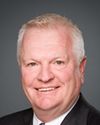No. With of PBN, you have to get into three-dimensional geometry of sorts. PBN allows aircraft to fly precise curves and arcs and to keep absolutely precise distances from each other, and to do this totally independent of anything on the ground, with no ground-based aid. It doesn't have to fly over a certain beacon at a certain physical location. They can now work in this beautiful choreographed area. The navigation is so precise. They can do all these smooth arcs. They no longer have to fly way out down there for ten miles, turn left, turn left again, line up with this beacon, and then come in. It all smoothly works in that way.
That's what people are noticing. They didn't used to see airplanes going around that way before. The airplanes had to fly these inefficient patterns and add miles and miles to the approach. Now they don't have to.
The point I was trying to make about the noise is that the aircraft are higher and they aren't causing a noise issue, in our view. Certainly where we've done this in other cities, and Vancouver was one example, we have literally put out noise-monitoring machines and proven that there's no noise. In fact, the noise is below the ambient noise level of the community.
So we'll see, but people do get emotional about this noise issue.




